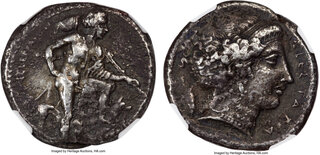| Heritage World Coin Auctions > CSNS Signature Sale 3115 | Auction date: 8 May 2024 |
| Lot number: 31003 Price realized: This lot is for sale in an upcoming auction - Bid on this lot  | Show similar lots on CoinArchives Find similar lots in upcoming auctions on |
| Lot description: Ancients SICILY. Segesta. Ca. 405-400 BC. AR tetradrachm (27mm, 17.47 gm, 6h). NGC Choice VF 5/5 - 2/5, Fine Style. ΕΓΕΣΤΑΙΩΝ, the hero Aegestes standing right, nude but for chlamys draped over left arm, pileus slung over left shoulder, strap over right shoulder, two javelins in left hand resting on left shoulder, resting left foot on rock; two hounds standing right at his feet, one sniffing the ground, small ithyphallic herm left before / ΣΕΓΕΣΤΑΞΙΑ, head of the nymph Segesta right, wearing triple pendant earring and pendant necklace, hair bound in sphendone and star embroidered saccos; grain ear left below. McClean 2555. SNG Copenhagen -. HGC 2, 1108. This exquisite dark charcoal piece is minted from remarkable Fine Style dies, beautifully depicting Aegestes in a moment of rest and contemplation with his two hounds. The reverse showcases a captivating portrait of the nymph Segesta, rendered in the timeless Classical Greek style, achieving a stunning simplicity. The Segesta tetradrachm of 405-400 BC provides a fascinating glimpse into the historical and mythological narratives surrounding the ancient city of Segesta, and its entanglement in the tumultuous wars between Athens and Carthage. Segesta gradually introduced tetradrachms around 415 BC, coinciding with the shifting dynamics of Sicilian coinage and political alliances. The dog on the obverse of Segesta's earlier coins commemorates the city's origins, and after 405 BC the tetradrachm broke with the imagery of previous obverse types by depicting a hunter with his hounds sitting at a lookout: perhaps symbolizing Segesta's position in the escalating conflicts of neighboring powers. One year previous, the city had requested Punic protection against Greek aggression, which led to the destruction of many Sicilian cities by the Carthaginians. Ultimately the incessant warring allowed Carthage to establish dominance over Sicily. Servius the Grammarian's 'Commentary on the Poems of Virgil' contains the most complete retelling of the founding myth of Segesta: "When King Laomedon denied Neptune and Apollo the promised reward for the construction of the city walls, Neptune, angered, sent sea monsters to ravage Troy. Apollo, also angered, responded by decreeing that noble maidens should be thrown to the beasts. The nobleman Hippotes, fearing for his daughter Aegesta--with princess Hesione already chained to a rock--sent her away on a ship, wherever chance might take her. She was carried to Sicily by the winds from the river Crimisus, who was in the form of a dog; there she then gave birth to Aegestes, who, named after his mother, founded a city for the Trojans, which today is called Segesta." https://coins.ha.com/itm/ancients/greek/ancients-sicily-segesta-ca-405-400-bc-ar-tetradrachm-27mm-1747-gm-6h-ngc-choice-vf-5-5-2-5-fine-style/a/3115-31003.s?type=DA-DMC-CoinArchives-WorldCoins-3115-05082024 HID02906262019 © 2024 Heritage Auctions | All Rights Reserved Estimate: 15000-20000 USD |  |



